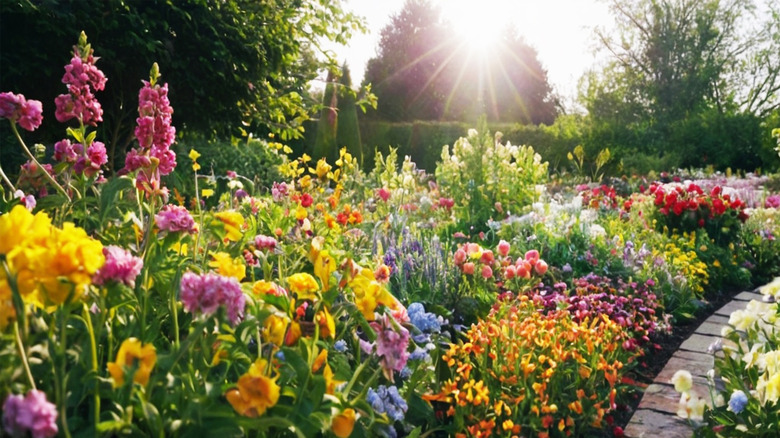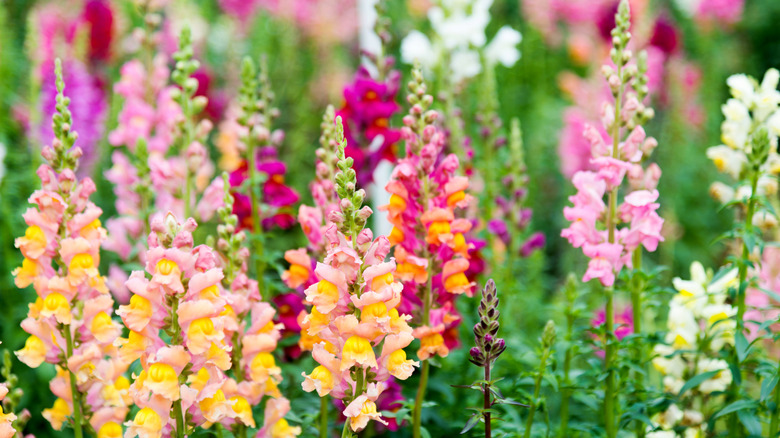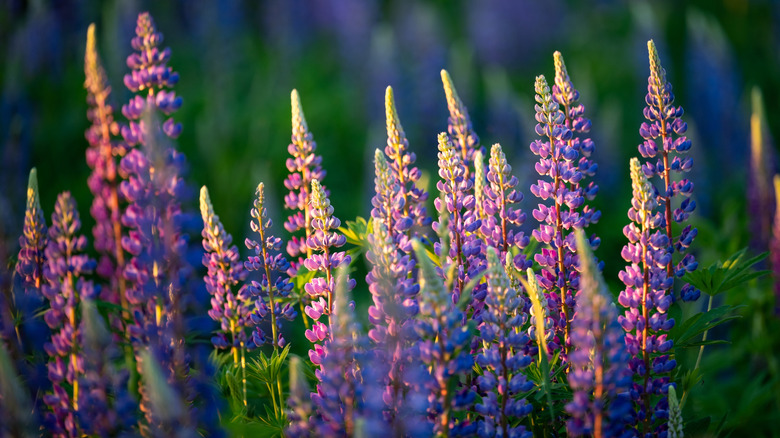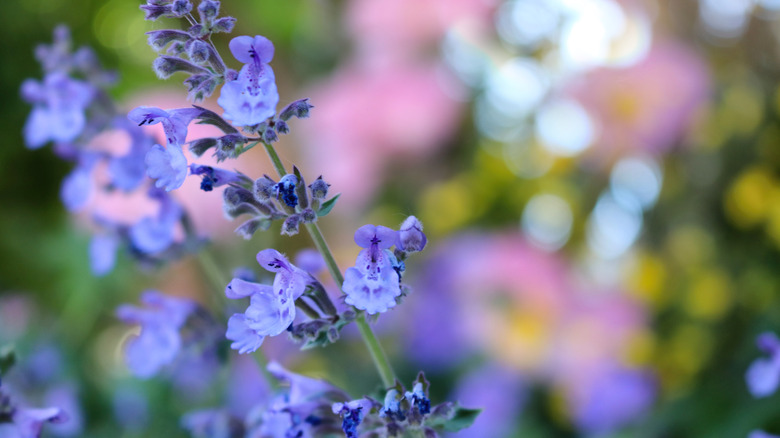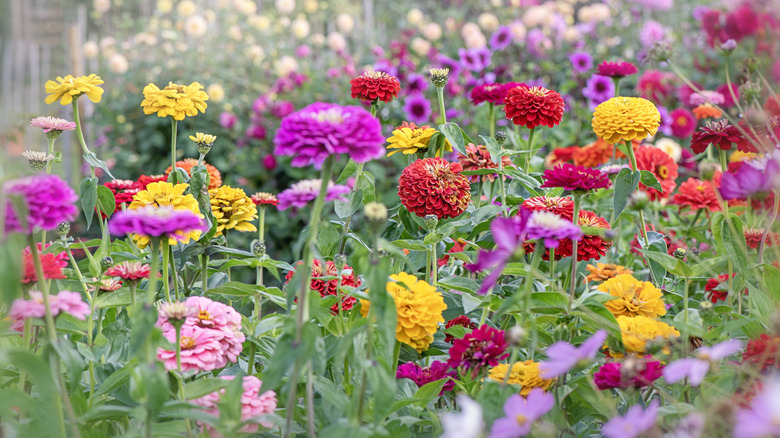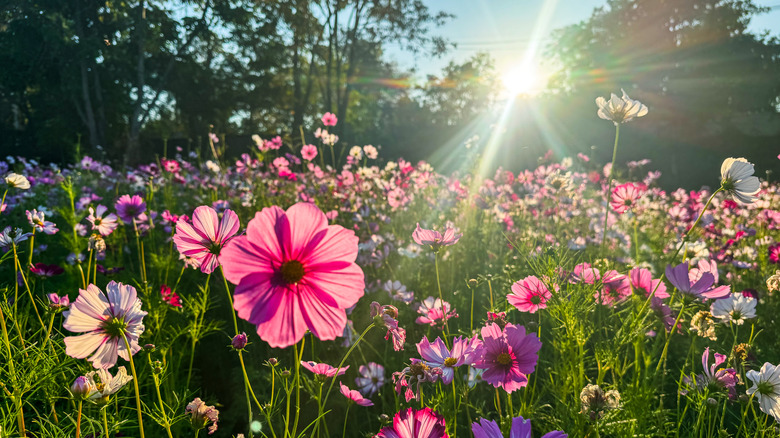10 Fast-Growing Spring Flowers For A Colorful Garden In No Time
Spring is in the air! If you're anything like us, that means you're eager to get outside to dig in the dirt and add a little color to the yard after a long, dreary winter. If you didn't plan ahead last fall by planting spring-blooming bulbs for a colorful garden, then you may be casting around for ideas to give your yard a quick hit of early season color.
If you're looking for instant gratification, you can run to the nearest store and likely find pansies (Viola × wittrockiana), violets (Viola), and hellebore (Helleborus orientalis) ready to go in the ground. These cold-hardy plants will bring color to the landscape when most plants are just getting started. However, if you're looking for flowers to grow from seed to give you a blast of color and continue on throughout the season, there are plenty of options. From plants that only need a few weeks to mature to others that start blooming in spring and last all summer long, you can mix and match options to keep your garden looking its best throughout the growing season.
Snapdragons
If it is color you want, snapdragons (Antirrhinum majus) have got it! Not only do they boast dozens of flowers on one stem, but they come in a wide variety of colors and sizes. The plants can bloom from April until frost if deadheaded regularly depending on your growing zone. Start these from seed indoors eight to ten weeks before your last frost date. Snapdragons prefer rich soil that is well-drained but moist and can do well in containers or in the ground.
Lupine
Sundial lupine (Lupinus perennis) and bigleaf lupine (Lupinus polyphyllus) are both native to North America, but in areas like Maine, bigleaf lupine is now considered potentially invasive. So, be careful when buying seeds or starter plants. These perennials typically begin to bloom in May, helping to bridge that mid to late spring gap. You can direct sow outdoors or start them indoors four to eight weeks before the last frost.
Catmint
Another plant that will bring color to the garden in May is catmint (Nepeta racemosa), and this one will keep the blooms coming until September. It's tolerant of drought conditions and does well in average soil as long as it's well-drained. Learn how to care for catmint plants if you would like to add these purple, pollinator-friendly plants to the garden. Catmint matures in just 14 to 21 days, making them good candidates to start from seed.
Borage
Borage (Borago officinalis) is a Mediterranean herb that can handle poor soil and thrives in full sun. With star-shaped blue or white flowers, it can also start blooming in June and run right through August. Not only is it edible, but bees love it. If you planted it in your garden last year, there's a good chance borage will pop up again despite being an annual — it tends to reseed itself. If you're growing it for the first time, it needs just 50 days to mature.
Zinnia
Another June bloomer is the ever-popular zinnia (Zinnia elegans). Ranging in height from 1-foot to 4-foot tall and available in a wide variety of colors, there is a zinnia for everyone. Zinnias like evenly-most soil that has plenty of humus, but are fairly easy to grow. In fact, you can sow zinnias directly outdoors every week or so to be sure you have a constant flush of color all summer long. If growing them from seed, they will take just over two months to mature.
Cosmos
If you like zinnias, then cosmos (Cosmos bipinnatus) may be another great option for you. They offer similar height and color options, but have a more delicate flower. They also bloom in June, bringing more color to late spring and early summer gardens. With proper care and deadheading, cosmos will keep blooming until the first frost, so they really are a workhorse in the garden. Direct sow outdoors after the danger of frost, just be sure not to cover them with too much soil as they require light for germination.
Marigold
It takes marigolds (Tagetes) just eight weeks to bloom. Even though these bright yellow and orange flowers are typically associated with summer, planting them indoors can give them a headstart so they are ready to go outside as soon as the danger of frost has passed. If you deadhead them to promote new flowers, marigolds will bloom from June until the first frost. Like many of the other plants on the list, they are easy to grow in well-drained soil.
Calendula
If you like marigolds and zinnias, calendula (Calendula officinalis) should also be on your list. Similar in look and color to these other flowers, calendula can be seeded outdoors before the last frost. They are shorter-lived, however, blooming from May to June. They don't love summer heat, but when the cool weather returns you may get repeat blooms if you're lucky.
Nasturtium
Nasturtium (Tropaeolum majus) is different from many of the other options on this list. This vining plant can be used as a climber or groundcover, and is often used as a companion plant to deter insects naturally. To get earlier blooms, soak the seeds for a few hours before starting them indoors about four to six weeks before the last frost. Plucking spent flowers will encourage reblooming throughout the season.
Morning Glory
Like nasturtium, morning glories (Ipomoea purpurea) are vigorous climbers, and can grow up to 10 feet in a single season. For best results, nick the outside of the seeds and soak for 24 hours before planting. They are sensitive to cold, so consider starting them indoors to give them a jump start. By June you should have colorful blooms that will last until the fall frost.
